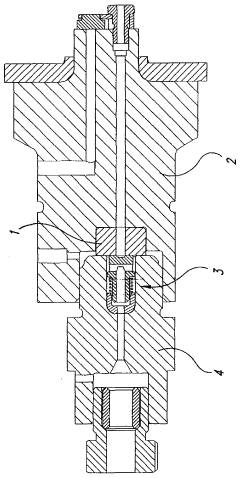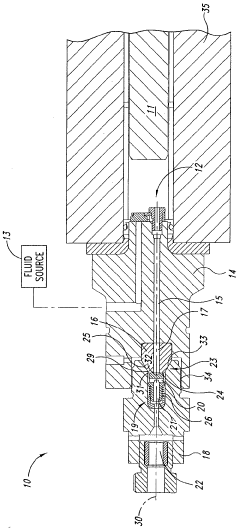Improving The Durability Of Check Valves
Technology Background And Goals
The analysis will cover the evolution of relevant technologies, assess market demands and industry trends, and provide insights into the competitive landscape and major players involved. By examining core patents and technical literature, the report aims to uncover the innovative value and potential breakthroughs in addressing the durability challenges of check valves.
Check Valve Market Demand Analysis
- Market Size and Growth
Analyze the current market size for check valves and forecast its growth potential, considering factors like industrial expansion, infrastructure development, and replacement demand. - Application Sectors
Identify key application sectors driving the demand for check valves, such as oil and gas, water and wastewater treatment, power generation, and chemical processing industries. - Regional Demand Patterns
Examine regional variations in check valve demand, highlighting regions with high growth potential and the factors influencing demand, such as regulatory standards and economic development. - Demand Drivers and Challenges
Discuss the primary drivers fueling the demand for check valves, including factors like reliability, safety, and energy efficiency requirements. Also, address challenges that may hinder market growth, such as competition from alternative technologies or economic uncertainties.
Technology Status And Challenges
- Valve Durability Challenges Check valves face durability issues due to wear, corrosion, and fatigue from cyclic operation, leading to leakage, sticking, and failure.
- Material Limitations Conventional materials like metals and elastomers have limited resistance to harsh environments, high temperatures, and aggressive media.
- Design Constraints Complex valve geometries and tight clearances make it difficult to achieve optimal flow patterns and minimize wear.
- Maintenance Requirements Regular maintenance and replacement are necessary, resulting in downtime and increased operational costs.
Current Technical Solutions
01 Check valve design for improved durability
Incorporating robust materials, reinforced components, optimized flow paths, and wear-reducing mechanisms to enhance durability and extend service life.- Check valve design for improved durability: Incorporating wear-resistant materials, optimizing valve geometry, and reducing wear on critical components to enhance durability and extend service life.
- Check valve materials for durability: Using corrosion-resistant alloys, ceramics, and high-strength materials to withstand harsh conditions and minimize wear.
- Check valve sealing mechanisms for durability: Innovative sealing designs like metal-to-metal or specialized elastomeric seals to prevent leakage and minimize wear, extending service life.
- Check valve maintenance and monitoring for durability: Condition monitoring, predictive maintenance, and periodic inspections to identify potential issues and enable timely interventions, preventing premature failure.
- Check valve applications and operating conditions for durability: Considering temperature, pressure, flow rates, and fluid properties in design and selection to ensure long-term durability for specific applications and operating conditions.
02 Check valve materials for durability
Using corrosion-resistant alloys, high-strength polymers, and composite materials to withstand harsh conditions and minimize wear and tear.Expand Specific Solutions03 Check valve sealing mechanisms for durability
Specialized sealing materials, optimized sealing geometries, and mechanisms to prevent leakage and ensure proper sealing under various operating conditions.Expand Specific Solutions04 Check valve maintenance and monitoring for durability
Periodic inspections, condition monitoring, and predictive maintenance techniques to identify potential issues and take preventive measures, extending durability.Expand Specific Solutions05 Check valve applications and operating conditions for durability
Considering temperature, pressure, flow rates, and fluid properties when designing and selecting check valves for optimal durability based on specific applications and operating conditions.Expand Specific Solutions
Technology Main Player Analysis
Cameron International Corp.
Robert Bosch GmbH
Key Technology Interpretation
- The check valve has a frustoconical end region and a tapered mating surface that securely fits within the outlet check valve body, improving the sealing and durability.
- The check valve seat is biased against an end surface by a spring and external pressure, ensuring a tight seal and preventing leakage.
- The poppet design allows pressurized fluid to flow through the check valve seat when the pressure is sufficient, enabling reliable operation at high pressures.
Environmental Impact of Check Valve Materials
The materials used in the construction of check valves can have a significant impact on the environment throughout their lifecycle. From the extraction and processing of raw materials to the manufacturing, operation, and eventual disposal or recycling of the valves, various environmental factors must be considered.
During the raw material extraction and processing stages, the mining and refining of metals like stainless steel, bronze, or other alloys can contribute to air and water pollution, energy consumption, and greenhouse gas emissions. Responsible sourcing and sustainable practices in these early stages are crucial for minimizing the environmental footprint.
In the manufacturing phase, the production processes involved in fabricating check valve components may consume energy and generate waste materials, such as metal shavings, chemical byproducts, or hazardous substances. Implementing efficient manufacturing techniques, recycling programs, and proper waste management strategies can help mitigate these impacts.
During the operational phase, the durability and reliability of check valve materials play a crucial role in minimizing potential leaks or failures, which could lead to environmental contamination. Selecting materials with superior corrosion resistance, strength, and compatibility with the conveyed fluids can extend the service life of the valves and reduce the need for frequent replacements, thereby conserving resources and minimizing waste.
At the end of their useful life, the disposal or recycling of check valves must be carefully managed. Proper recycling practices can recover valuable materials and reduce the demand for new raw materials, while improper disposal can lead to soil and water contamination. Implementing effective recycling programs and adhering to relevant regulations are essential for responsible end-of-life management.
Furthermore, the selection of check valve materials should consider their potential impact on the environment during operation. Materials that are non-toxic, non-leaching, and compatible with the conveyed fluids can minimize the risk of environmental contamination in case of leaks or spills.
Overall, a comprehensive life cycle assessment of check valve materials, considering factors such as resource extraction, manufacturing processes, operational performance, and end-of-life management, is crucial for minimizing the environmental impact and promoting sustainable practices in the industry.
Regulatory Standards for Check Valve Durability
Regulatory standards play a crucial role in ensuring the durability and reliable performance of check valves across various industries. These standards are established by recognized organizations and governing bodies to maintain safety, quality, and consistency in valve manufacturing and operation.
One of the primary regulatory standards for check valve durability is the American Society of Mechanical Engineers (ASME) Boiler and Pressure Vessel Code (BPVC). This comprehensive code provides guidelines for the design, fabrication, inspection, and testing of pressure vessels and related components, including check valves. It specifies material requirements, manufacturing processes, and performance criteria to ensure the durability and integrity of check valves under various operating conditions.
Another important standard is the American Petroleum Institute (API) Specification for Check Valves, which is widely adopted in the oil and gas industry. This standard outlines the requirements for the design, materials, testing, and documentation of check valves used in petroleum and natural gas production, refining, and transportation applications. It addresses factors such as corrosion resistance, pressure ratings, and temperature ranges to enhance the durability of check valves in harsh environments.
The International Organization for Standardization (ISO) also provides relevant standards for check valve durability, such as ISO 16137 for industrial valves and ISO 10497 for testing of valves. These standards establish uniform guidelines for valve design, materials, testing methods, and performance evaluation, ensuring consistent quality and durability across different manufacturers and regions.
In addition to these overarching standards, various industry-specific regulations and codes may apply to check valve durability, depending on the application and operating environment. For example, the Nuclear Regulatory Commission (NRC) has specific requirements for check valves used in nuclear power plants, while the American Water Works Association (AWWA) provides standards for valves used in water distribution systems.
Compliance with these regulatory standards is essential for manufacturers, operators, and end-users to ensure the durability and reliable performance of check valves. Regular inspections, maintenance, and adherence to recommended practices outlined in these standards can help extend the service life of check valves and minimize the risk of failures or incidents.


